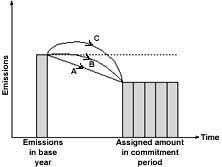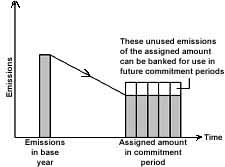3.5 & 3.6:
Flexibilities for countries with economies in transition
These sub-paragraphs provide certain flexibilities for economies in transition listed
under Annex 1. While the base year or period for the implemention of commitments will
remain the same for those economies in transition which have already had their’s set
pursuant to the Decision 9 of CoP-2, others which have not yet submitted their first
national communication under Article 12 of the FCCC can notify the MOP the historical base
year or period other than 1990 for the implementation of its commitments. But the MOP will
decide on the acceptance of this notification. The MOP will provide economies of
transition with a certain degree of flexibility in order to enhance their ability to
address climate change. This was also agreed to in sub-clause 4(6) of the FCCC. According to the Decision 9 of CoP-2,
Bulgaria was granted the base year of 1989, Poland 1988, Romania 1989 and Hungary the base
period of 1985-87.
3.7 & 3.8: How to
calculate the emissions reductions objectives stipulated for the first commitment period
This sub-paragraph explains how Annex I countries will calculate their emissions
reductions in the first commitment period, which is from 2008 to 2012, a period of five
years. These countries will individually take their 1990 "aggregate anthropogenic
carbon dioxide equivalent emissions of the greenhouse gases listed in Annex A (of the
KP)" and multiply this figure by five. Then each country will ensure that its total
reductions during the entire period of 2008 to 2012 when compared to the 1990 figure
multiplied by 5 is equal to or less than the percentage ascribed to that country in Annex
B.
In other words, let us assume
that country X had in 1990 aggregate anthropogenic carbon dioxide equivalent emissions of
greenhouse gases listed in Annex A equal to 10 million tonnes of carbon equivalent (or
10mtC). Then, in the period 2008 to 2012, in case of Annex B states whose QUELROS is 92
per cent, its total aggregate anthropogenic carbon dioxide equivalent emissions of
greenhouse gases must not be more than 10mtC x 5 x 0.92, or 46mtC during the entire
commitment period or an average of 9.2 mtC per year during the commitment period.
But the KP leaves one big loophole here in
terms of its ability to actually control build up of greenhouse gases. The KP does not
specify any quantification of the ‘emissions pathway’ between the base year 1990
and the commitment period. Let us assume a country remains very profligate in emissions
between 1990 and 2005 and then cuts then rapidly to meet its QUELROS in the commitment
period of 2008 to 2012, or it runs into an economic crisis leading to emissions
reductions, then it would have met its targets set under the KP but it would still have
added an enormous amount of emissions to the global atmosphere thus accelerating the
problem of global warming.
While pathway A shown below would be ideal,
the KP does not prohibit countries from taking other pathways which would be inimical to
the build-up of greenhouse gases in the environment.
 The sub-paragraph further
states that those Annex 1 countries in which land-use changes and forestry activities
constituted in 1990 net emissions of greenhouse gases (which means the total emissions
from sources were more than the total absorption of emissions by sinks) can add these net
emissions to their base year emissions of 1990 and thus increase their base year
emissions. The sub-paragraph further
states that those Annex 1 countries in which land-use changes and forestry activities
constituted in 1990 net emissions of greenhouse gases (which means the total emissions
from sources were more than the total absorption of emissions by sinks) can add these net
emissions to their base year emissions of 1990 and thus increase their base year
emissions.
This would obviously make it
easier for countries to meet their reductions targets in the commitment period of 2008 to
2012, especially if those land-use changes and forestry activities have come to a halt
after 1990.
Economies in transition which are covered
by sub-clause 3.5 can take the base year or commitment period they have notified to
calculate their emissions reductions.
Paragraph 8 states that Annex 1 countries
can take 1995 as the base year for estimating their QUELROS with respect to the three
gases — hydrofluorocarbons (HFCs), perfluorocarbons and sulphur hexafluoride —
which are helping to reduce damage to the ozone layer, a threat which is being addressed
by the Montreal Protocol on Substances that Deplete the Ozone Layer. These gases have a
potential to cause global warming.
3.9: Commitments for
subsequent commitment periods
Commitments for subsequent periods will be established in accordance with Article 21.7 of
the KP. The MOP will start consideration of these commitments at least 7 years before the
end of the first commitment period, which means that this exercise will begin before the
start of 2006.
3.10, 3.11 & 3.12:
Substraction/Acquisition of emissions units/assigned amounts from other parties
These paragraphs set rules for the benefits that an Annex I party can get from other Annex
1 or non-Annex 1 parties. These nations will have to follow the rules set by Article 6
which deals with Joint Implementation activities, Article 12 which deals with the Clean
Development Mechanism, and Article 17 which deals with emissions trading.
The difference between Article 6
and Article 12 is that the former deals with Joint Implemention between Annex 1 countries
and the latter deals with Joint Implemention between Annex 1 countries and non-Annex 1
countries, which is now being called the Clean Development Mechanism.
According to these three
paragraphs, countries can transfer and/or accept :
emissions reduction units;
parts of assigned amounts; and,
certified emissions reductions.
Countries accepting any of the above will
add them to their assigned amounts. Taking the case of country X cited above, if it
accepts emissions reduction units or an assigned amount of 1mtC from country Y which has
an assigned amount of 100 mtC, then the assigned amount of country X will go up from 46
mtC to 47 mtC. It thus has to make less effort to reduce its emissions domestically.
Meanwhile, countries transferring emissions
reduction units or assigned amounts will have to reduce their assigned amounts
accordingly.
In other words, if country Y
transfers 1mtC to country X, then the assigned amount of country Y will go down from
100mtC to 99 mtC. So only those Annex I countries can transfer emissions only if they know
they will be well below their assigned amounts, like Russia, or non-Annex I countries
which do not have assigned amounts.
3.13: Banking unused
assigned amounts for future use
This paragraph states that if the emissions of an Annex 1 country are less than its
assigned amount for the first commitment period, then this difference can be added to the
assigned amount of that country in subsequent commitment periods.
In other words, an Annex I
country can now "bank" its emissions reduction for use by its future generations
(see diagram below). And as the language of the paragraph does not restrict this benefit
to the first and second commitment periods, it means that this benefit has been provided
for all future commitment periods.
 This provision raises a major
question about the interests of the future generations of non-Annex I nations, namely,
developing countries. While most of these countries have very low per capita emissions,
and are therefore emitting much less than what would be their assigned amounts, especially
if it was based on a system of equal per capita entitlements, these countries do not have
the benefit of banking emissions for future use. But a country like Russia which currently
has very low emissions because of its economic crisis, can now bank its unused emissions
for future use. In other words, the KP has created a system of entitlements for Annex I
countries which are major producers of greenhouse gases but not a system of entitlements
for non-Annex I nations which are generally low producers of greenhouse gases. This provision raises a major
question about the interests of the future generations of non-Annex I nations, namely,
developing countries. While most of these countries have very low per capita emissions,
and are therefore emitting much less than what would be their assigned amounts, especially
if it was based on a system of equal per capita entitlements, these countries do not have
the benefit of banking emissions for future use. But a country like Russia which currently
has very low emissions because of its economic crisis, can now bank its unused emissions
for future use. In other words, the KP has created a system of entitlements for Annex I
countries which are major producers of greenhouse gases but not a system of entitlements
for non-Annex I nations which are generally low producers of greenhouse gases.
3.14: The need
to minimise adverse impacts on developing countries of actions taken by industrialised
countries to meet their commitments
This paragraph states that Annex 1 countries must ensure that their actions do not result
in adverse social, environmental or economic impacts on all developing countries and
especially those identified in paragraphs 4.8 and 4.9 of the FCCC and listed above. In
case there are possibilities of adverse effects, efforts will be made to minimise these
adverse effects.
The first MOP will consider what actions
are necessary to minimise adverse effects of climate change and/or impacts of response
measures by Annex I countries on developing countries. Among other issues, MOP-I will
discuss funding, insurance and technology transfer. |